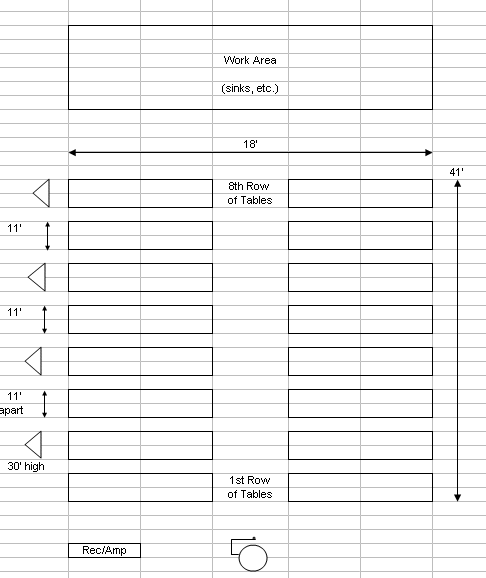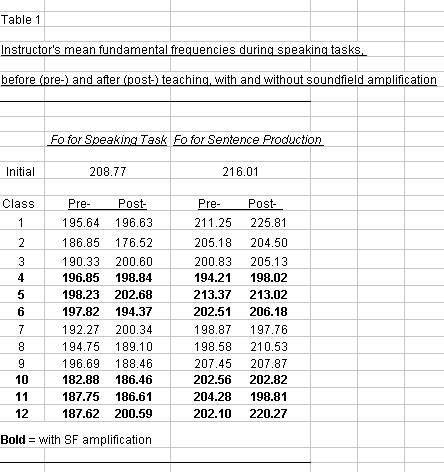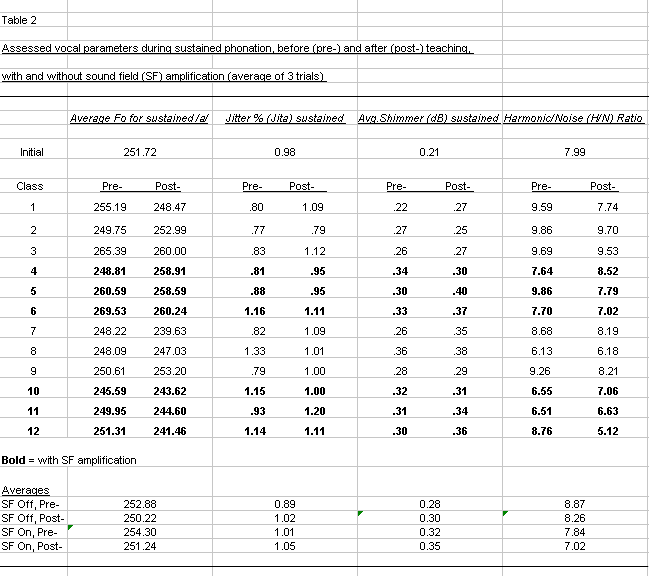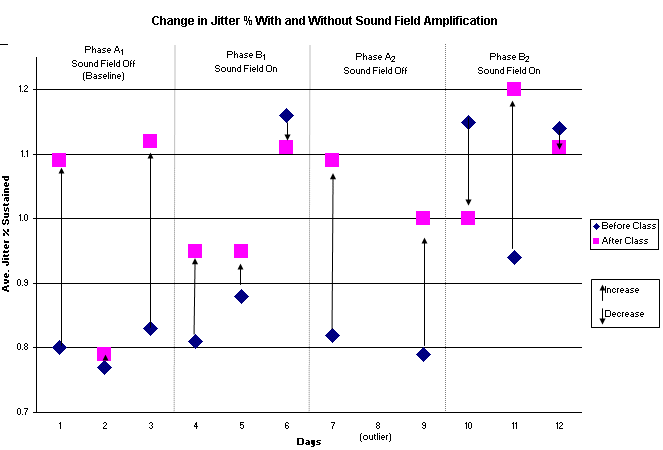Duquesne University
Introduction:
Due to the energy and strain involved in providing oral instruction and education, teachers experience more voice problems than the general population (Calas, Verhulst, Locoq, Dalleas, & Seilean, 1989; Gotaas & Starr, 1993). Recent studies have demonstrated that prolonged voice use affects acoustic vocal parameters, often results in vocal fatigue, and may change vocal fold appearance and glottic closure patterns. In addition to excessive vocal use, teachers are considered to be at high-risk for vocal complaints because of increased speaking volume associated with background noise (Sapienza, Crandell, & Curtis, 1999).
In an effort to reduce this occupational health hazard, elementary and secondary schools have been using sound field amplification. Sound field (SF) amplification is a technology similar to high fidelity public address systems, whereby the speaker wears a microphone and his or her voice is amplified and transmitted throughout the classroom (or sound field). SF amplification has been shown to have positive effects on student learning (e.g., Rosenberg et al., 1999). However, little information has been collected regarding the effects of amplification on the vocal health of the classroom instructor. Although it has been shown that using SF amplification reduces pressure levels in speaking (Sapienza et al., 1999), it has not been determined if the use of SF amplification also results in changes in other vocal characteristics.
The purpose of this pilot study was to assess vocal characteristic information obtained from a classroom instructor in two conditions: with and without SF amplification. It was hypothesized that changes in jitter, shimmer, and harmonic-to-noise (H/N) ratio would be less when the teacher's voice was amplified compared to the nonamplified condition.
Methods:
A college professor (female, age 33) served as the subject of this study. She was a self-referral to her university's Speech-Language-Hearing Clinic, presenting with complaints of vocal strain and frequent hoarseness after teaching in adverse acoustic conditions. As a licensed physician, she served on the faculty of a training program for physician assistants. At the start of the study, she was 5 months pregnant. She had been teaching at the university level for less than one year. She was a nonsmoker, and her client case history was negative for prior vocal complaints or health problems. Prior to the study, a baseline acoustic analysis was performed and the subject's vocal mechanism was examined by a speech-language pathologist and an otolaryngologist via videostrobe to rule out baseline pathologies.
The classroom used in this study was long and narrow, measuring 18 feet wide and 66 feet long, with an average ceiling height of 10 feet (see Figure 1). Approximately 25% of the ceiling surface was covered with vents, fans, and heating system ducts. The walls were primarily painted brick, the floor was linoleum, and half of the back wall consisted of a glass window overlooking a busy street. The reverberation time (RT) was 3.15 seconds, far exceeding the recommended minimal RT of 0.8 seconds (Acoustical Society of America, 2000).
Figure 1. Schematic of classroom setting showing placement of tables and speakers.
Noise sources in the room included traffic noise from the window in the back wall and two overhead fans. The sound level in the room when unoccupied was 57dBA. The instructor's natural speaking level was measured at 12 feet away at 60 dBA, providing a signal-to-noise ratio of +3 dB. Typical procedures for improving the acoustics of a classroom are: first, to reduce noise sources and then, second, to reduce reverberation with absorbent surface treatments (e.g., carpeting and acoustic ceiling tile, see Crandell & Smaldino, 2000). However, these were not immediately available options, so the strategy used here (increasing the signal-to-noise ratio with SF amplification) would not be the recommended practice for a long-term solution to poor classroom acoustics.
Voice samples were collected and evaluated using Kay Elemetrics CSL 4300B. The subject was placed in a sound-proof booth for all collection samples. A head-mounted microphone was used at a constant mic-to-mouth distance of 6 inches and a consistent sampling rate was obtained at all times.
During the treatment phases of the study, the instructor used a wireless boom microphone (Phonic Ear AT 665M), and the room was amplified using four speakers with an Easy Listener system (PE 210). Two speakers were positioned under the two fans, and the remaining two were placed in between (see Figure 1). The volume of the teacher's microphone was set to provide +12 dB signal-to-noise ratio output to all listeners. Sound levels were measured with a Quest 2400 sound level meter.
Research Design:
To establish a functional relationship between vocal strain and SF amplification, an ABAB design was implemented. A baseline of vocal characteristics was collected during the first three classes (Phase A), while the subject taught as she had in the past. The SF amplification treatment (Phase B) was used full time during the next three classes; the treatment was withheld for the subsequent three classes (Phase A) and then reintroduced the next three classes (Phase B). This design accommodated two days of exams (class with no lecture) and the limited availability of borrowed SF equipment.
Procedures:
The subject taught class for 1.5 hours twice a week, primarily using lecture format and occasional role-playing activities. Immediately before and after class, the instructor provided a voice sample, which was acoustically analyzed during sustained phonation and running speech tasks. Sustained /a/ (8 sec.) was used to obtain: 1) frequency 2) harmonic-to-noise (H/N) ratio, 3) jitter percent (expressed as jitter %/Jitt) and 4) shimmer (dB). Both a sustained and automatic speech task (counting) and a sentence production task ("where are you going?") were used to measure mean fundamental frequency in order to examine significant changes in average speaking pitch across trials and conditions. Throughout all tasks, the subject's baseline amplitude was within normal limits.
Results:
Subject's Voice Measures -
Table 1 provides average fundamental frequency (Fo) data during speaking tasks at baseline evaluation and pre/post-class. These data reveal no significant change in average Fo after prolonged voice use, with or without amplification. Therefore, speaking pitch (Fo) remained stable after both conditions and across days and trials. 
Table 2 displays average data of three trials of sustained phonation /a/. Parameters extracted were average Fo, jitter, shimmer (dB), and harmonic-to-noise (H/N). The table reports initial baseline measures for these parameters and pre/post-class measures for both amplified and non-amplified conditions. Averages at the bottom show little change in shimmer and H/N in either condition (SF on or off). However, notable change in jitter can be seen when SF was off, but not when it was on. 
A visual inspection of the data suggests reason for concern about the jitter values obtained before class on Day 8. A Grubb's test (also called the extreme studentized deviate or ESD method) determined that this value was a significant outlier (p
Statistical Data For "N of 1" studies, a nonparametric alternative to the t-test, called a permutation test, is used to determine statistical significance. The first procedure is to compute a test statistic; in this case, the absolute difference of sums of values in two groups (vocal characteristic measures, before and after class) was obtained. An alpha level of 0.05 was set, and then the data were systematically rearranged into every possible nonredundant arrangement. The test statistic was computed for every arrangement by the PERMUSTAT program (Hayes, 1996).
No significant differences were noted in shimmer or in harmonic-to-noise (H/N) ratios when using or not using SF amplification. However, the increase in jitter when teaching without amplification was statistically significant (one-tail p value [t > 4.2231]
Graphical Data Single subject research conventionally presents data in a graphical display (Barlow & Herson, 1984). Figure 2 provides information on the one vocal characteristic (jitter) that demonstrated significant changes across conditions. This figure indicates the following:
Phase A1: The subject's jitter measures increased 3 of 3 days when teaching without amplification, with a mean increase of 20% (range = 2 to 29%).
Phase B1: The subject's jitter measures increased on 2 of 3 days with amplification, with a mean increase of 10% (range = 7 to 14%). On the remaining day, jitter decreased 5%.
Phase A2: The subject's jitter measures increased 2 of 2 days (discounting outlier), with a mean increase of 24% (range = 21-27%).
Phase B2: The subject's jitter measures increased 1 of 3 days, by 27%. The other two days, jitter decreased with a mean average of 9% (range = 3-15%).
Summary: jitter increased each day the subject taught without amplification. Jitter increased to a lesser degree on 3 of the 6 days teaching with amplification; on three days, jitter actually decreased after teaching with amplification. 
Figure 2. Graphical display of changes in jitter % during each phase of study.
Discussion:
This pilot study attempted to find a relationship between teaching in acoustically poor conditions and vocal parameters correlating to voice disturbance. In this N-of-1 study, it was found that jitter increased significantly when teaching without SF amplification, but did not increase significantly when SF amplification was used.
Statistical Significance:
The advantage of a single-subject design is the ability to investigate whether a particular treatment worked for a particular subject (rather than the "average" subject) (Franklin, Gorman, Beasely, & Allison, 1996).
In this study, the dependent variable was the use of SF amplification, and the independent variable was its effects on vocal characteristics, compared to nonuse. For this one subject, the probability that an increase in jitter was related to teaching without SF amplification was greater than 95%. Although jitter was observed when teaching with SF amplification, it did not change significantly from before-class measurements. It can be concluded that this treatment worked for this subject.
Clinical Significance:
While statistical significance refers to the probability of the occurrence of nonchance differences, clinical significance is said to occur "when an intervention results in important change for the subject, irrespective of the intervention's statistical properties" (Franklin et al., 1996, p. 135). Measures of frequency perturbation correlate to vocal qualities described as dysphonia or "hoarseness;" therefore, an increase in jitter in the nonamplified condition suggests that prolonged voice use at increased volume results in a negative effect on vocal functioning.
Anecdotally, the subject reported reduction of vocal fatigue when using the SF system, and expressed regret that she had to discontinue use during Phase B1. These results indicate that clinical significance did occur, since the intervention resulted in an "important change for the subject" by reducing the amount of vocal strain experienced while teaching - the reason for her self-referral.
Limits of this pilot study:
Limitations to the generalization of this study begin with the obvious concern of having only one subject. In addition, there were two possible threats to internal validity: pregnancy and everyday stress. Little is known about the effects of pregnancy on vocal parameters (P. Pollice, M.D., personal communication, October 2, 2001), but it is possible that hormonal changes could have a bearing on vocal parameters. Intrasubject variability also could not be controlled with regard to variable stressors experienced by the subject before she taught class.
The limited ability to demonstrate full experimental control (with the elimination of data collected on Day 8) added a threat to external validity. Although the remaining two days of Phase A2 were quite similar to those in Phase A1, conclusions about reducing jitter with SF amplification are tentative because of incomplete data.
In addition, it would have been preferred to establish a more stable baseline; however, time and equipment access did not allow for changes in the original schedule.
Future Research:
This pilot study should be replicated with a larger number of subjects (non-smoking classroom instructors in good general health) who teach in a quiet room, to determine if vocal strain is still experienced in this environment.
Also still to be determined are these questions: does gender, age, or pregnancy influence results? What kind of results would be obtained after a full day of teaching- the typical experience of elementary and secondary teachers?
Conclsion:
A significant amount of research has established that teachers are a high-risk group for voice disorders and vocal pathologies such as vocal fold nodules. Conventional recommendations to remediate these voice problems include the use of SF amplification; however, very little data have been published to verify the efficacy of this recommendation.
This pilot study indicated that vocal stress was reduced when SF amplification was used by one classroom instructor; additional studies are needed to provide conclusive support for this standard recommended treatment.
Acknowledgement:
The authors extend appreciation to Ms. Liz Trice of Phonic Ear for her assistance in providing equipment for this study.
References:
Acoustical Society of America. (2000). Classroom acoustics: A resource for creating learning environments with desirable listening conditions. Melville, NY: Author.
Barlow, D., H., & Herson, M. (1984). Single case experimental designs: Strategies for studying behavior change. New York: Pergamon.
Calas, M., Verhulst, J., Locoq, M., Dalleas, B., & Seilean, M. (1989). Vocal pathology of teachers. Review of Laryngology, Otology, and Rhinology, 110, 397-406.
Crandell, C., & Smaldino, J. (2000). Current practices in classroom sound field FM amplification. Journal of Educational Audiology, 8, 9-17.
Franklin, R. D., Gorman, B. S., Beasley, T. M., & Allison, D. B. (1996). Graphical display and visual analysis. In R. D. Franklin, D. B. Allison, & B. S. Gorman (Eds.), Design and analysis of single-case research (pp. 119-158). Mahwah, NJ: Lawrence Erlbaum Associates.
Gotaas, C., & Starr, D. (1993). Vocal fatigue among teachers. Folia Phoniatric, 45, 120-129.
Hayes, A. (1996). Randomization tests for the MacIntosh. Behavior Research Methods, Instruments, and Computers, 28, 473-475.
Rosenberg, G., Blake-Rahter, P., Heavner, J., Allen, L., Redmond, B., Phillips, J., & Stigers, K. (1999). Improving classroom acoustics: A three-year FM sound field amplification system. Journal of Educational Audiology, 7, 8-28.
Sapienza, C., Crandell, C., & Curtis, B. (1999). Effects of sound-field frequency modulation amplification on reducing teachers' sound pressure level in the classroom. Journal of Voice, 13(3), 375-381.
Sound Field Amplification and the Teaching Voice
July 29, 2002
Related Courses
1
https://www.audiologyonline.com/audiology-ceus/course/assessing-auditory-functional-performance-goals-33024
Assessing Auditory Functional Performance: Goals and Intervention Considerations for Individuals with Hearing Loss
Functional auditory assessment and continuing assessment is critical in order to determine the current level of function, develop appropriate goals for intervention, and achieve maximum outcomes. Learning to listen drives everything else: speech intelligibility, language competence, reading, academics, and life-long learning. This course offers a detailed look at functional auditory assessment and intervention, to provide audiologists with a better understanding of hearing loss in children in terms of the broader speech, language, learning and academic contexts. Additional videos to demonstrate key points will be included.
auditory, textual, visual
129
USD
Subscription
Unlimited COURSE Access for $129/year
OnlineOnly
AudiologyOnline
www.audiologyonline.com
Assessing Auditory Functional Performance: Goals and Intervention Considerations for Individuals with Hearing Loss
Functional auditory assessment and continuing assessment is critical in order to determine the current level of function, develop appropriate goals for intervention, and achieve maximum outcomes. Learning to listen drives everything else: speech intelligibility, language competence, reading, academics, and life-long learning. This course offers a detailed look at functional auditory assessment and intervention, to provide audiologists with a better understanding of hearing loss in children in terms of the broader speech, language, learning and academic contexts. Additional videos to demonstrate key points will be included.
33024
Online
PT60M
Assessing Auditory Functional Performance: Goals and Intervention Considerations for Individuals with Hearing Loss
Presented by Susan G. Allen, MED, CED, MEd, CCC-SLP, LSLS Cert. AVEd
Course: #33024Level: Intermediate1 Hour
IACET/0.1
Functional auditory assessment and continuing assessment is critical in order to determine the current level of function, develop appropriate goals for intervention, and achieve maximum outcomes. Learning to listen drives everything else: speech intelligibility, language competence, reading, academics, and life-long learning. This course offers a detailed look at functional auditory assessment and intervention, to provide audiologists with a better understanding of hearing loss in children in terms of the broader speech, language, learning and academic contexts. Additional videos to demonstrate key points will be included.
2
https://www.audiologyonline.com/audiology-ceus/course/seminars-children-auditory-access-37383
Learning for Children with Auditory Access Needs: Insights Gained During COVID, presented in partnership with Seminars in Hearing
Remote learning for deaf and hard-of-hearing students during COVID resulted in both predictable and unpredictable challenges as well as some expected benefits. During this presentation, we will focus on communication access modifications in the use of remote microphone (RM) systems as well as other access accommodations.
auditory, textual, visual
129
USD
Subscription
Unlimited COURSE Access for $129/year
OnlineOnly
AudiologyOnline
www.audiologyonline.com
Learning for Children with Auditory Access Needs: Insights Gained During COVID, presented in partnership with Seminars in Hearing
Remote learning for deaf and hard-of-hearing students during COVID resulted in both predictable and unpredictable challenges as well as some expected benefits. During this presentation, we will focus on communication access modifications in the use of remote microphone (RM) systems as well as other access accommodations.
37383
Online
PT60M
Learning for Children with Auditory Access Needs: Insights Gained During COVID, presented in partnership with Seminars in Hearing
Presented by Cheryl DeConde Johnson, EdD
Course: #37383Level: Intermediate1 Hour
AAA/0.1 Intermediate; ACAud inc HAASA/1.0; AG Bell - LSLS/1.0 Domain 1, Domain 7, Domain 8; AHIP/1.0; ASHA/0.1 Intermediate, Professional; BAA/1.0; CAA/1.0; Calif. SLPAB/1.0; IACET/0.1; IHS/1.0; Kansas, LTS-S0035/1.0; NZAS/1.0; SAC/1.0
Remote learning for deaf and hard-of-hearing students during COVID resulted in both predictable and unpredictable challenges as well as some expected benefits. During this presentation, we will focus on communication access modifications in the use of remote microphone (RM) systems as well as other access accommodations.
3
https://www.audiologyonline.com/audiology-ceus/course/school-audiology-and-community-partnerships-30988
School Audiology and Community Audiology Partnerships
This course will focus on the critical partnership between educational/school audiology and community audiology services. Issues that maximize educational and communication outcomes for school-aged children will be highlighted.
auditory, textual, visual
129
USD
Subscription
Unlimited COURSE Access for $129/year
OnlineOnly
AudiologyOnline
www.audiologyonline.com
School Audiology and Community Audiology Partnerships
This course will focus on the critical partnership between educational/school audiology and community audiology services. Issues that maximize educational and communication outcomes for school-aged children will be highlighted.
30988
Online
PT60M
School Audiology and Community Audiology Partnerships
Presented by Gail Whitelaw, PhD
Course: #30988Level: Intermediate1 Hour
AAA/0.1 Intermediate; ACAud inc HAASA/1.0; AG Bell - LSLS/1.0 Domain 8; BAA/1.0; CAA/1.0; Calif. SLPAB/1.0; IACET/0.1; IHS/1.0; Kansas, LTS-S0035/1.0; NZAS/1.0; SAC/1.0
This course will focus on the critical partnership between educational/school audiology and community audiology services. Issues that maximize educational and communication outcomes for school-aged children will be highlighted.
4
https://www.audiologyonline.com/audiology-ceus/course/pediatric-connectivity-beyond-the-phone-39445
Pediatric Connectivity: Beyond the Phone
Learn about the different types of connectivity and how to integrate hearing devices with video game systems, educational tools, and a variety of accessories. This course discusses how to counsel/instruct patients to pair and use their devices with more than a phone.
auditory, textual, visual
129
USD
Subscription
Unlimited COURSE Access for $129/year
OnlineOnly
AudiologyOnline
www.audiologyonline.com
Pediatric Connectivity: Beyond the Phone
Learn about the different types of connectivity and how to integrate hearing devices with video game systems, educational tools, and a variety of accessories. This course discusses how to counsel/instruct patients to pair and use their devices with more than a phone.
39445
Online
PT60M
Pediatric Connectivity: Beyond the Phone
Presented by Kat Tribulski, AuD
Course: #39445Level: Intermediate1 Hour
AAA/0.1 Intermediate; ACAud inc HAASA/1.0; AG Bell - LSLS/1.0 Domain 1; AHIP/1.0; ASHA/0.1 Intermediate, Professional; BAA/1.0; CAA/1.0; Calif. SLPAB/1.0; IACET/0.1; IHS/1.0; Kansas, LTS-S0035/1.0; NZAS/1.0; SAC/1.0
Learn about the different types of connectivity and how to integrate hearing devices with video game systems, educational tools, and a variety of accessories. This course discusses how to counsel/instruct patients to pair and use their devices with more than a phone.
5
https://www.audiologyonline.com/audiology-ceus/course/supporting-families-children-with-hearing-36381
Supporting Families of Children with Hearing Loss: What Parents Want from their Audiologist
Parents and caregivers rely on their audiologist to help develop their understanding of their child’s hearing loss. According to recent research, parents' needs go well beyond the use and care of their child’s hearing technology. Within the framework of Self-Determination Theory, this presentation will discuss the topics and resources families value as being most important.
auditory, textual, visual
129
USD
Subscription
Unlimited COURSE Access for $129/year
OnlineOnly
AudiologyOnline
www.audiologyonline.com
Supporting Families of Children with Hearing Loss: What Parents Want from their Audiologist
Parents and caregivers rely on their audiologist to help develop their understanding of their child’s hearing loss. According to recent research, parents' needs go well beyond the use and care of their child’s hearing technology. Within the framework of Self-Determination Theory, this presentation will discuss the topics and resources families value as being most important.
36381
Online
PT60M
Supporting Families of Children with Hearing Loss: What Parents Want from their Audiologist
Presented by Dave Gordey, PhD
Course: #36381Level: Intermediate1 Hour
AAA/0.1 Intermediate; ACAud inc HAASA/1.0; AG Bell - LSLS/1.0 Domain 5; ASHA/0.1 Intermediate, Professional; BAA/1.0; CAA/1.0; Calif. SLPAB/1.0; IACET/0.1; IHS/1.0; Kansas, LTS-S0035/1.0; NZAS/1.0; SAC/1.0
Parents and caregivers rely on their audiologist to help develop their understanding of their child’s hearing loss. According to recent research, parents' needs go well beyond the use and care of their child’s hearing technology. Within the framework of Self-Determination Theory, this presentation will discuss the topics and resources families value as being most important.


